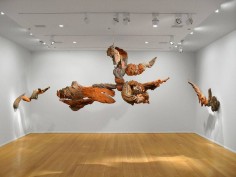CHARLES SIMONDS
MENTAL EARTH
source: charles-simonds
Since 1970 Simonds has created Dwelling places for an imaginary civilization of “Little People” who are migrating through the streets of neighborhoods in cities throughout the world; New York, Paris, Shanghai, Berlin, London, Dublin, among others. Each Dwelling is a different time and place in the history of the lives of Little People, a chronology of some of the Dwellings that have been photographed is available below. A listing of the cities Simonds has worked in is located here.
.
.
.
.
.
.
.
.
source: artinamericamagazine
Forty years ago, Charles Simonds began building, in crumbling corners of downtown Manhattan, tiny brick dwellings meant to house a mythical race of “Little People.” The scratchy, jumpy videos that document these efforts now themselves seem reports from an apocryphal land. They were on view upstairs in this sampling of mostly new work, Simonds’s first solo exhibition in New York in a decade. (A sculpture of his has lodged in the stairwell of the Whitney Museum since 1981; it matches two further works perched on buildings across the street.)
Although the grim Lower Manhattan of those videos—several shot by Rudy Burckhardt—is nearly unrecognizable today, Simonds’s work has not changed in essence. His materials now include metal, polyurethane, paper and/or plaster, but clay remains primary, and almost everything else imitates it. Early on, he performed as a kind of primitive mud man—a genial, prostrate Kim Jones; other early videos, as well as a group of 22 still photos from 1970 called Birth, show Simonds emerging gloopily from soft clay, or submitting, Gulliver-style, to the little brick cities he builds on his supine, naked body. While he has long since taken himself out of the picture, he continues to work in the streets of various cities, unannounced and largely undocumented. And while the new, discrete sculptures are big and wildly inventive, they are still meant to serve Little People. The conceit—which he has elaborated in various statements—should be hopelessly corny but isn’t, because, like the best fantasy worlds, it seems to have as much to do with controlling nightmares as indulging daydreams.
The show’s centerpiece was Mental Earth (2002), a majestic hanging sculpture 10 feet wide, its four massive limbs, or wings, spiraling outward at head height. At its center are velvety red deserts spiked with nails and riven with glowing orange streambeds; further out are virulent growths of brick towers, their minuscule detailing maniacally precise. There are twisted ropes of yeasty, golden-brown clay and oozy, bubbly outcroppings of a distinctly Jules Verne-ish cast. Sublime, apocalyptic, absurd and commanding, Mental Earth is described by Arthur Danto in the exhibition catalogue as evoking an Annunciation; Simonds himself cites the Winged Victory of Samothrace. Neither seems an overreach.
Sprouting from the walls were four smaller but no less compelling sculptures (all 2011), which similarly manifest the “conflation of body, land and energy” that Simonds says is his motivation. Rounding out the show were two bone-white porcelain works, one a ball of tumbleweed and the other a thorn bush, both made at Sèvres and displayed under glass; they appear to have sprung from ghost towns.
Born under the sign of an Aquarian back-to-the-land movement and harbored in the margins of Post-Minimalism, Simonds’s handmade productions now find company in the work of precision homemakers like Do Ho Suh and Brian Tolle. Simonds, the son of two psychoanalysts, creates primal scenes distinguished by a combination of wondrous delicacy and manic energy.
.
.
.
.
.
.
.
source: charles-simonds
Simonds often creates works that address a particular space, place and history. Some are connected to exhibitions, and some are indoors, and some are outdoors. Click on the images below to view a selection of installation images.


